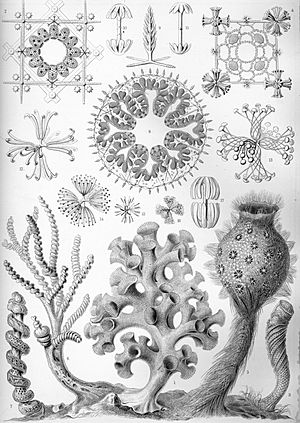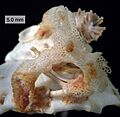Hexactinellid facts for kids
Quick facts for kids Hexactinellid spongesTemporal range: Cambrian - Recent
|
|
|---|---|
 |
|
| "Hexactinellae" from Ernst Haeckel's Kunstformen der Natur, 1904 | |
| Scientific classification | |
| Kingdom: | |
| Phylum: | |
| Class: |
Hexactinellida
Schmidt, 1870
|
| Subclasses | |
|
Amphidiscophora |
|
Hexactinellid sponges are special types of sponges. They are often called glass sponges because their skeletons are made of tiny, sharp pieces of silica, which is like glass. These tiny pieces, called spicules, have four or six points.
Amazing Glass Sponges
Glass sponges are not very common. You can usually find them deep in the ocean, about 450 to 900 meters (1,476 to 2,953 feet) down. However, one type, Oopsacas minuta, lives in shallow water. Other kinds have been found even deeper. You can find glass sponges in all oceans, but they are most common near the Antarctic and in the Northern Pacific Ocean.
These sponges often look like cups. They can be from 10 to 30 centimeters (4 to 12 inches) tall. Inside, they have strong, criss-cross skeletons made from fused silica spicules. Their bodies are quite symmetrical. Many species have a large central space that opens to the outside through a sieve-like structure made of their skeleton. Some types of glass sponges can even join together to form large reefs. They are usually light in color, from white to orange.
Most of a glass sponge's body is made of something called syncytial tissue. This is a special kind of tissue where many cell nuclei share one large area of cytoplasm. Unlike other sponges, glass sponges do not have typical outer skin cells. Instead, they have a net of amoebocytes, which are like moving cells. Their spicules poke through this net. Also, unlike other sponges, glass sponges cannot shrink or contract their bodies.
One amazing thing about glass sponges is their unique system for sending electrical signals very quickly. This allows them to react fast to things happening around them. Some glass sponges, like the "Venus' flower basket", have a bunch of fibers that stick out from the bottom of their skeleton, like an upside-down crown. These fibers are 50 to 175 millimeters (2 to 7 inches) long and are about as thick as a human hair.
Sponge Reefs
Glass sponges can form huge underwater structures called sponge reefs. These reefs are found off the coast of British Columbia and Washington State. Scientists study them as part of the Sponge Reef Project. Some reefs found in Hecate Strait, British Columbia, are truly massive. They can be up to 7 kilometers (4.3 miles) long and 20 meters (66 feet) high! Before these discoveries, people thought that sponge reefs had died out completely during the Jurassic period, millions of years ago. Finding them alive today was a big surprise!
Images for kids
See also
 In Spanish: Hexactinélidos para niños
In Spanish: Hexactinélidos para niños






